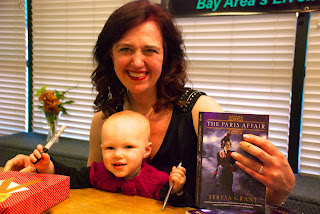Forensic Detection & the Historical Sleuth
In a blog interview I did around the release of The Paris Affair, Heather Webb asked a question that got me to thinking about forensics in historical mysteries. So much of present day mysteries, in books, on television, in movies, involves analyzing forensic evidence. My Malcolm and Suzanne Rannoch have no CSIs, medical examiners, or forensic anthropologists to assist them in gathering and analyzing data. On the other hand, even without 21st century technology sleuths can still forensic evidence. C.S. Harris has a doctor character whose analysis of corpses is often of key help to Sebastian St. Cyr. The Victorian Sherlock Holmes was, as my father liked to say, a classic empiricist, his solutions built from the data he gathers. Both John Watson and Mary Russell frequently record him bemoaning the lack of data.
Like other literary investigators in the 19th century and earlier, Malcolm and Suzanne look at footprints, find stands of hair or threads of fabric caught on cobblestones of table legs or left behind on sheets. Of course they can’t do DNA or chemical analysis, but they can do is compare the color of the hair or fabric or look at where the mud left behind by a shoe might have come from. If they’re really lucky someone drops a distinctive earring. They can use lividity and rigor to roughly arrive at time of death They can sometimes determine from a wound whether the killer is left or right handed.
Of course as a writer there are times the lack of sophisticated forensic analysis presents challenges in how one's detectives will solve the mystery. On the other hand, sometimes it can complicate matters in a good way. A killer in a crime of impulse, who probably would not be wearing gloves, would most likely to caught much more easily today than in the days before fingerprinting, let alone DNA analysis.
Writers, how do you deal with the lack of modern day technology in your books? Readers, what are some of your favorite examples of forensic analysis in an historical setting?
photo: Raphael Coffey
Like other literary investigators in the 19th century and earlier, Malcolm and Suzanne look at footprints, find stands of hair or threads of fabric caught on cobblestones of table legs or left behind on sheets. Of course they can’t do DNA or chemical analysis, but they can do is compare the color of the hair or fabric or look at where the mud left behind by a shoe might have come from. If they’re really lucky someone drops a distinctive earring. They can use lividity and rigor to roughly arrive at time of death They can sometimes determine from a wound whether the killer is left or right handed.
Of course as a writer there are times the lack of sophisticated forensic analysis presents challenges in how one's detectives will solve the mystery. On the other hand, sometimes it can complicate matters in a good way. A killer in a crime of impulse, who probably would not be wearing gloves, would most likely to caught much more easily today than in the days before fingerprinting, let alone DNA analysis.
Writers, how do you deal with the lack of modern day technology in your books? Readers, what are some of your favorite examples of forensic analysis in an historical setting?
photo: Raphael Coffey



Comments
Post a Comment